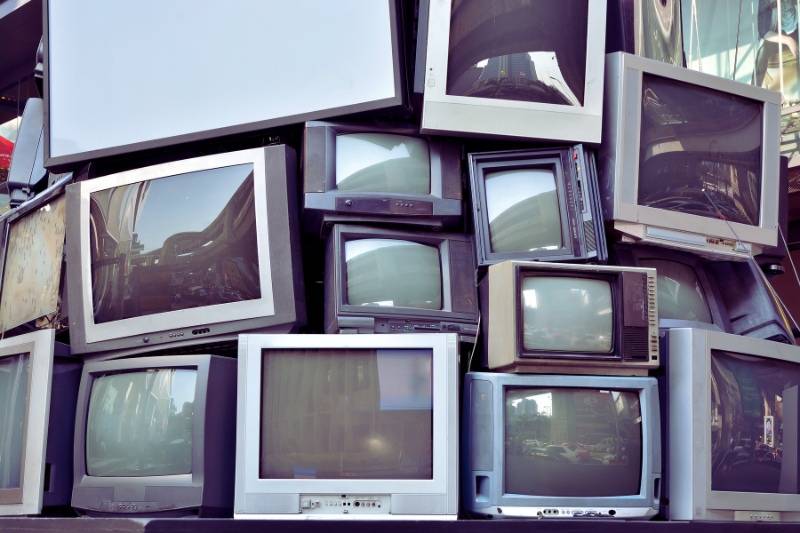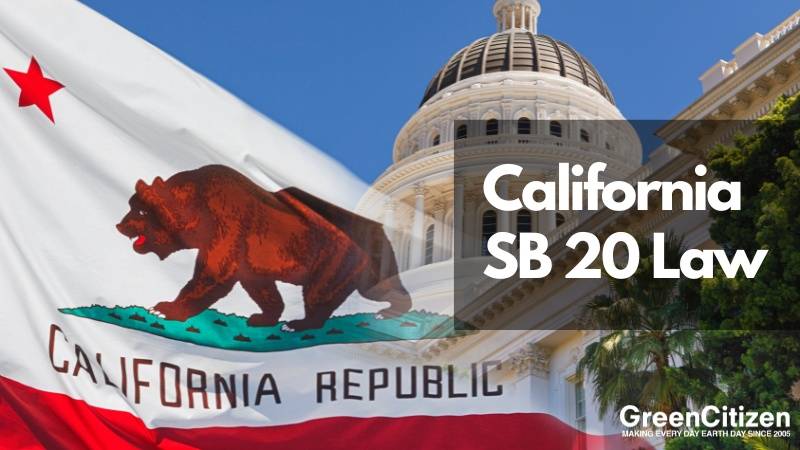California Senate Bill 20 (SB 20), later known as the Electronic Waste Recycling Act of 2003, tackles the rising problem of electronic waste (e-waste) in California.
E-waste includes discarded electronics like TVs, computer monitors, and video display devices. These items contain harmful materials like lead, mercury, and cadmium, which can harm the environment and health.
SB 20 set up a statewide system to safely recycle and dispose of these devices, helping reduce the risks they pose. This law is crucial in managing e-waste and protecting our environment.
In this blog, we’ll dive deeper into the bill and explore its role in California’s recycling system. We’ll also discuss what this law means for everyday users and recyclers.
What Is the Purpose of California’s SB 20 E-Waste Recycling Law?
California’s SB 20 was created to tackle the growing e-waste problem. In the early 2000s, many households were piling up old electronics, like TVs and monitors, due to fast changes in technology. A study by the California Integrated Waste Management Board showed over 6 million obsolete devices were stored in homes, and the number was growing daily.
E-waste is dangerous because it contains harmful chemicals that can pollute soil and water if not disposed of properly. Recycling e-waste was also expensive for local governments, and much of the waste was illegally sent to developing countries, where it was handled without proper safety measures.
SB 20 was introduced to solve these issues by:
- Creating a financially sustainable, eco-friendly system for recycling e-waste.
- Shifting the cost of e-waste disposal from local governments to producers and consumers.
- Encouraging manufacturers to design safer, easier-to-recycle products.
What Items Fall Under the California SB 20 Law?
Under SB 20, the Electronic Waste Recycling Act of 2003, certain electronic devices are subject to the electronic waste recycling fee. These devices are often referred to as covered electronic devices (CEDs).
The initial CEDs listed under the SB 20 recycling fees, back in 2005, only included 4-inch or above CRT and LCD/LED displays for televisions, desktops, laptops, and portable DVD players. However, they didn’t include items like smartphones or tablets that are ever-so-common these days.
The good thing is that the list is getting updated regularly, aiming to include all modern displays that contain hazardous materials.
Covered Items or CEDs (Updated July 2022):
- Cathode ray tube (CRT) devices
- Cathode ray tubes (CRTs)
- Computer monitors with CRTs
- Laptops with liquid crystal display (LCD) screens
- Desktop monitors with LCD screens
- Televisions with CRT screens
- LCD televisions
- Plasma televisions
- Portable DVD players with LCD screens
- OLED televisions*
- OLED laptops*
- OLED tablets*
- OLED desktop monitors*
- LCD tablets
- LCD smart displays
*Note: OLED-containing devices were added through an emergency rulemaking package by DTSC, approved on December 20, 2021, and effective as of July 1, 2022.
Non-CEDs (Updated July, 2022):
- Video display devices that are part of a motor vehicle.
- Video display devices that are part of industrial, commercial, or medical equipment, including monitoring or control devices.
- Video display devices that are built into household appliances like clothes washers, dryers, refrigerators, freezers, microwaves, ovens, dishwashers, air conditioners, dehumidifiers, or air purifiers.
- Electronic devices that no longer fall under the CED category as per Health and Safety Code, Section 25214.10.1(e).
5 Key Aspects of California SB 20

1. Introducing Electronic Waste Recycling Fee
One of the key parts of SB 20 is the introduction of an electronic waste recycling fee. Starting on July 1, 2005, retailers were required to collect a fee from consumers at the time of purchase for certain electronic devices. The fee varies depending on the screen size and is used to fund the collection, transportation, and recycling of e-waste.
For those of us living in California, starting January 1, 2005, a fee ranging from $6 to $10 was added when purchasing an SB 20 item.
Retailers are responsible for sending these fees to the California Integrated Waste Management Board, which deposits them into the Electronic Waste Recovery and Recycling Account. This account was created to support California’s e-waste recycling programs, ensuring proper handling and disposal of hazardous materials found in electronic devices.
The fees later saw a revision in 2008. This time the fee was a bit higher, ranging from $8 for screens smaller than 15-inches to $25 for screens larger than 35-inches.
The current fees are much lower though. Starting January 1, 2020, we’ve been paying:
- $4 for screens larger than 4 inches but less than 15
- $5 for screens between 15 and 35 inches
- $6 for screens 35 inches or more
And a fun fact: when purchasing an SB20 item, that recycling fee isn’t taxed. Plus, recycling your SB20 items at places like GreenCitizen is free, thanks to the prepaid recycling fee.
2. Manufacturer Responsibilities Under SB 20
SB 20 assigns key duties to manufacturers of covered electronic devices. By July 1, 2005, manufacturers must:
- Clearly label their products to show the brand or manufacturer’s name.
- Submit yearly reports to the state, detailing the number of devices sold, the hazardous materials used, and the amount of recycled content in their products.
- Provide consumers with easy-to-access information on how and where to recycle their devices, through toll-free numbers, websites, or printed materials included with the product.
These requirements aim to boost transparency and hold manufacturers accountable for their environmental impact. They also push companies to innovate by reducing harmful materials and making their products more recyclable.
3. Recycling Payments for Collectors and Recyclers
SB 20 sets up a payment system to encourage electronic waste collection and recycling. Authorized collectors and recyclers in California’s e-waste program can receive recovery and recycling payments. These payments help cover the costs of collecting, transporting, and recycling e-waste.
Every two years, the payment rates are reviewed and adjusted to keep up with expenses.
To qualify, recyclers must meet strict requirements, including following health and safety standards and allowing inspections by state agencies. These rules ensure that e-waste is safely managed and follows environmental regulations, protecting both people and the environment.
4. Export Restrictions on E-Waste
SB 20 includes strict rules on exporting e-waste. Anyone looking to ship e-waste abroad must inform the state and prove it will be managed according to international environmental standards. This prevents hazardous e-waste from being sent to developing countries, where improper handling can harm the environment and public health.
Exporters must show that the destination country allows e-waste imports, the waste will be managed following the Organization for Economic Co-operation and Development (OECD) guidelines, and that it’s meant for recycling or reuse, not just disposal.
This ensures safer e-waste handling globally.
5. The Role of Local Governments in E-Waste Management
SB 20 outlines how local governments must help manage e-waste. Since 2004, cities, counties, and regional waste agencies must include e-waste collection and recycling in their Household Hazardous Waste Elements (HHWE) as part of their waste management plans.
This ensures local agencies promote e-waste recycling and make it a priority alongside other hazardous waste efforts. By integrating e-waste collection into existing programs, local governments actively keep harmful electronics out of landfills and encourage proper recycling.
Analyzing the Impact on Consumers and Retailers
SB 20 introduced a recycling fee at the point of sale for certain electronic devices, directly affecting consumers. While this fee adds a small extra cost, it helps cover the expense of e-waste management, which used to fall on taxpayers and local governments.
By paying this fee, consumers contribute to a system that makes recycling their old electronics free and more accessible, reducing the hassle of safely disposing of e-waste.
For retailers, SB 20 requires them to collect and remit the fee to the state. To ease this responsibility, they’re allowed to keep 3% of the fee to cover administrative costs. This setup helps reduce the financial burden on retailers while ensuring they remain compliant with the law.
It also encourages them to promote the recycling system, which benefits the entire community by reducing harmful e-waste in landfills.
Overall, this fee system creates a more sustainable e-waste management process, holding both consumers and retailers accountable. It helps spread the responsibility of recycling while offering an efficient way to handle old electronics.
However, the bill isn’t without flaws. While it has made great strides in improving e-waste management, certain issues and gaps remain. It’s not all as glorious as it seems, and there are challenges we’ll explore later. Despite its positive impact, SB 20 still leaves room for improvement in ensuring a more efficient and comprehensive recycling system.
Penalties and Enforcement Strategies

SB 20 enforces strict penalties for those who don’t follow the law. Retailers and manufacturers who don’t comply with fee requirements or sell non-compliant products can face fines between $2,500 and $25,000 per violation.
These penalties act as a strong deterrent, pushing manufacturers, retailers, and recyclers to follow the rules. The law ensures that all parties involved take responsibility, helping to maintain an effective e-waste recycling system.
By enforcing these fines, SB 20 keeps businesses accountable and strengthens California’s efforts to manage electronic waste safely.
Major Challenges and Criticisms of SB 20
While SB 20 has significantly improved e-waste recycling in California, it still faces several challenges and criticisms:
Limited Scope
The bill only covered a narrow range of electronic devices, focusing mainly on those with video displays, like televisions and computer monitors. Many other common electronics, such as smartphones, tablets, printers, and small gadgets, were initially excluded from the law’s regulations.
This means a large portion of e-waste was still not being properly managed or recycled under SB 20, leaving a gap in the system that many environmental advocates are concerned about.
Manufacturer Compliance
SB 20 requires manufacturers to report on their use of hazardous materials but does not enforce strict penalties for failing to reduce these harmful substances over time.
Although the bill promotes transparency, critics argue that it lacks strong enough incentives to push manufacturers toward designing eco-friendly products with fewer toxic materials like lead and mercury. Many believe more can be done to hold manufacturers accountable.
E-waste Exports
Despite the bill’s restrictions on exporting e-waste, illegal exports still occur, with hazardous waste sometimes ending up in developing countries. Once exported, it becomes difficult to ensure the waste is managed safely and responsibly, raising concerns about both environmental harm and human health risks abroad.
SB 20, while impactful, leaves room for improvement.
Amendments to SB 20: Adapting to Modern E-Waste Challenges
Since its enactment in 2003, the SB 20 Electronic Waste Recycling Act has undergone several amendments to keep up with evolving technology and the growing complexity of e-waste. These updates have expanded the program’s scope, adjusted fees, and enhanced regulations, ensuring the law remains effective in addressing modern e-waste issues.
2013 Amendment:
This key update expanded the list of devices covered by the recycling fee, reflecting the rise of new electronic products. By broadening the range of devices, the amendment ensured that more e-waste was subject to proper recycling protocols.
2016 Amendment:
To keep the program financially sustainable, adjustments were made to the Electronic Waste Recycling Fee. This allowed the program to continue functioning despite shifts in the type and volume of e-waste being generated.
2019 Amendment:
A significant update introduced stricter oversight on e-waste exports. It ensured that exported electronic waste complied with international environmental standards, preventing harmful disposal practices in developing countries.
SB 1215 (2022):
Looking ahead, an amendment set to take effect in 2026 will expand the program to include battery-embedded devices, like smartphones and wearable tech. This addresses the growing challenge of managing e-waste from products with non-removable batteries.
SB 568 (2023):
This amendment further tightened export regulations, ensuring exported e-waste is managed according to global environmental standards, strengthening California’s commitment to responsible e-waste handling.
These amendments reflect California’s proactive stance in adapting its recycling policies to meet the demands of changing technology and global environmental concerns.
The Impact of California Senate Bill 20
SB 20 has been a game changer for e-waste management, shaping how California handles electronic waste responsibly. By holding manufacturers, retailers, and consumers accountable, it has set a powerful example for other states to follow.
As a result, many states, including Connecticut, New York, and Illinois, later adopted similar producer responsibility laws for e-waste, using SB 20 as a blueprint.
The bill created a sustainable system for recycling electronics and pushed for innovation in product design, making them safer and easier to recycle. As e-waste continues to grow, the importance of such legislation becomes even more evident, reminding us of the need for ongoing efforts in responsible recycling.
